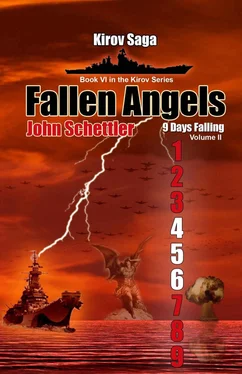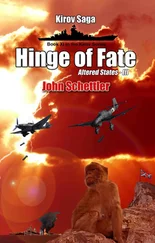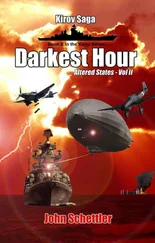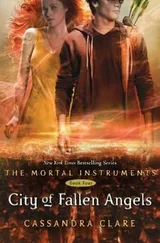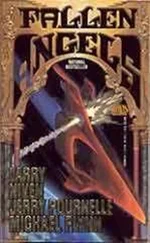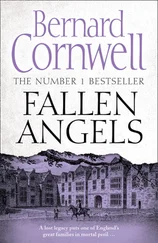They were correct.
* * *
Thelast of the Helldivers were spotted and ready for takeoff on the Big T, with something under its modified fuselage that looked very strange. Aviation Ordnanceman Julian Lowry was still scratching his head over the device, a fat 1700 pound bomb with wings! It had a big round nose that was crammed with gizmos, or so he had heard, though he never got a look inside.
“This thing like those Jap missiles?”
“Hell no,” said Boatswain’s Mate Rod Madison. “They stick some dumb ass in theirs and fly them like Kamikazes. Not like ours,” he pointed. “That sucker has its own radar.”
“What do you know about it, Boats?”
“We were working the decks in the lower munitions hold when they brought the damn thing in. I heard the briefing. It’s got radar in there, I tell you. That’s why they call it a bat.”
Madison was correct. They were looking at one of the world’s first “Smart Bombs,” named the ASM-N-2 BAT, (Mark 9). It was an amazing development by RCA, Western Electric and other talented engineering firms, deployed and tested for the first time in April of 1945 off Borneo where it sunk a couple Japanese merchant ships and damaged the escort ship Aguni from a firing range of 20 nautical miles. The first true “fire and forget” anti-ship weapon, over 3500 were built and deployed on numerous aircraft from bombers to seaplanes to the versatile Helldivers . The $700 million investment in the weapon was exceeded only by the Manhattan project. Clearly the Americans had seen what these rockets and radar guided weapons could do, and they were hot to deploy their own.
It had been a long time in development, with numerous models by various names designed before this model achieved success. The problem of how to guide a special weapon to the target was a daunting one first tackled by the Germans with their Fritz X, a glide bomb that was actually radio controlled and guided by a crewman in the bomber it was dropped from. The US wanted to use a bomb with its own radar instead, though one group argued it could easily be defeated by jamming and suggested a wacky, yet novel approach. They fixed a lens in the nose of the bomb that would project an image of the target ship onto a white screen. There, tucked away inside the nose of the bomb, they placed a pigeon trained to peck at the image, which generated signals from the sensitive wired screen that would serve to reorient the bombs air foils to correct the missile’s flight path! Needless to say, the radar advocates won the day.
“They say the Russians have guided rockets,” said Lowrey. “Spooked some of the pilots pretty bad last time up.”
“Yeah? Well take a good look, Lowrey. We’ve got the damn things too.”
“Did you see that big Russian bomb this morning?”
“Yeah, I saw it. We’ve got one too.”
“How you know all this, Boats?”
“You think they got something we don’t have yet? Get a clue, Lowrey. We had to ship the Russkies trucks and planes for years. If they have it, then we’ve got it too.”
The plane was loaded and on the flight line now, and the lucky man in the cockpit that day was Rod Bains. Signalman Bill Tomko was handling the flags as the engine revved up, and he was ready to wave the plane off when someone pointed at the sky. He craned his neck to have a look, first seeing the thick flights of Hellcats overhead as they formed up for the big strike run up north. Then he saw what Lowrey and the Boatswain’s mate were jaw-boning about, thin white streaks in the sky, coming in so fast he could hardly believe what he was seeing. The rockets ripped into the dense formations overhead with booming explosions. He saw three planes go up with the first fireball, their flaming remnants falling from the sky like wounded angels.
The Russians had pigeons too.
“Holy crap! Will you look at that! Where are they coming from?”
The skies overhead were soon a wild melee of wheeling aircraft and more missiles came streaking in from the north, eight in all. The signalmen gaped at the scene, their unbelieving eyes transfixed as the rockets exploded, one by one. There was something wrong about it, something unfair, like a boxing match where the two fighters were standing face to face with the referee and one man snapped a sharp jab at the other fellow before the bell even rang. The formations overhead were broken up and wheeling in all directions now, like angry bees.
Once the shock and amazement abated there was also palpable anger on the flight deck. Lowrey shook a fist at Bains, as if to urge him to go get some well deserved revenge. Bill Tomko was fired up and he snapped his flags back up pointing the way forward to the nose of the ship.
“Come on Bat Man, go get the sons-of-bitches, will ya?” With a snap of his arm the Helldiver was on its way, the Bat Bomb cradled under its fuselage and off to war.
Then the flying fish came in, and everything was chaos again. Someone pointed off the port side of the ship. “Hey, look out! More of them rockets coming in fast!”
Gunner’s mate Benny Benson barely got a look at them, three flying fish skimming low over the sea in the distance, leaving frothy white tails behind them as they raced in. Two veered off and he got a good side view for a second as they sped towards the light carrier Monterey , the third was headed right for Big T, and it came in with a roar and wallop unlike anything he had ever heard. A brilliant orange fireball lit up the port side of the ship, and the missile blasted through the thin side armor, plunging inside to the maintenance bays. It was lucky that all the planes were mostly in the air. The Bat Man was the last off the deck, his Helldiver laboring up with its heavy load.
Bains looked over his shoulder, saw Ticonderoga burning, and set his jaw tight, then wagged his wings in farewell, a signal that set the everyone on the flight deck cheering him on. At least twenty angels had fallen from the sky when the lightning fast rockets caught them in their tightly packed formations. Now all bets were off. The rest of the strike package was dispersing like a flight of scattering birds, flying off in all directions and altitudes as they had been told in the pre-flight briefing. The rockets would not find them huddled together again, and soon they were all heading north.
* * *
Karpovwas after the carriers first. He had pegged their positions with the long range AEW radars on the KA-226. Samsonov fired a salvo of eight P-400 missiles at each carrier group, hoping to catch the air formations early and hurt them. The eight missiles that had shaken up the Sprague’s group took down over twenty planes, and he had similar results against the Halsey group carriers. But the allies were getting cagy now. They immediately began dispersing their carriers at high speed, making each one an individual target instead of steaming them in a centralized task force. Each had an escort of two destroyers, particularly after three P-900s found Ticonderoga and Monterey , the latter hit badly by two missiles.
The blow changed all future history, at least in one respect, in a way that Karpov would never know. The General Quarters Officer of the Deck on Monterey was Gerald R. Ford, later to become the Vice President in Richard Nixon’s administration, and eventually the 38th President of the United States. He was once fated to be the longest lived president in US history, reaching the age of 93 years and 165 days, but all that was changed in a hot flash of fire and smoke from a Sizzler. The General Quarters OOD didn’t make it off Monterey alive.
It was shaping up to be a battle of attrition at first. The salvos against the carrier groups had expended all but one of Kirov’s P-900s. Only the number ten missile remained, and it was mounted with a ‘special warhead.’ Kirov still had seventeen Moskit-IIs nine MOS-III Starfires , and that last remaining P-900. The other ships in the flotilla could contribute another thirty missiles. The only question he had now was whether they could sufficiently disable the American combat power with limited conventional weapons, or whether they would be forced to resort to stronger measures.
Читать дальше
